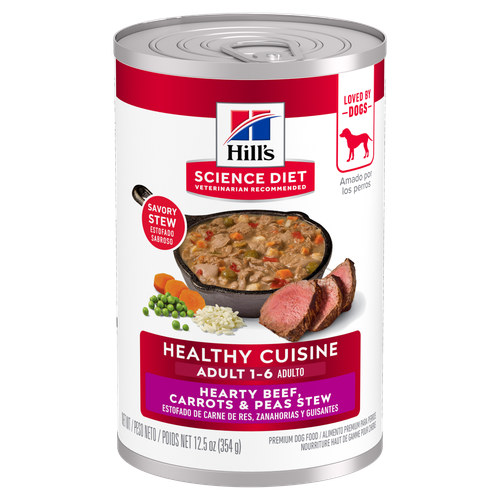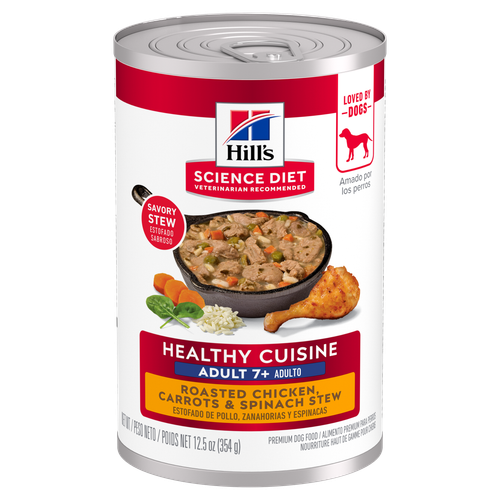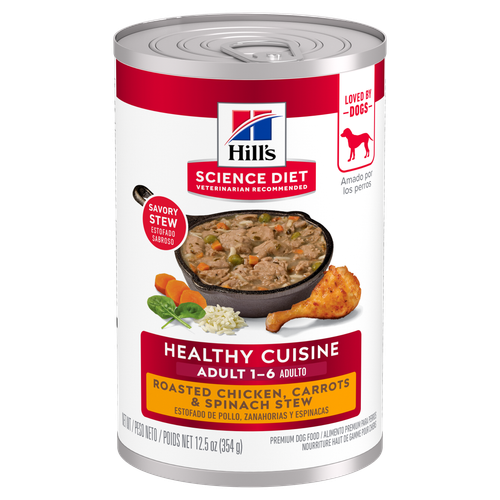
-
Find the right food for your petTake this quiz to see which food may be the best for your furry friend.Find the right food for your petTake this quiz to see which food may be the best for your furry friend.Featured products
 Adult Healthy Cuisine Hearty Beef, Carrots & Peas Stew Dog Food
Adult Healthy Cuisine Hearty Beef, Carrots & Peas Stew Dog FoodHearty beef paired with tender vegetables in a savory stew
Shop Now Adult 7+ Healthy Cuisine Roasted Chicken, Carrots & Spinach Stew Dog Food
Adult 7+ Healthy Cuisine Roasted Chicken, Carrots & Spinach Stew Dog FoodDelicious roasted chicken paired with tender vegetables in a succulent stew
Shop Now Adult Healthy Cuisine Roasted Chicken, Carrots & Spinach Stew Dog Food
Adult Healthy Cuisine Roasted Chicken, Carrots & Spinach Stew Dog FoodDelicious roasted chicken paired with tender vegetables in a succulent stew
Shop NowFeatured products Adult 7+ Indoor Chicken Recipe Cat Food
Adult 7+ Indoor Chicken Recipe Cat FoodSupports energy level and beautiful fur in mature indoor cats
Shop Now Adult Turkey & Liver Entrée Cat Food
Adult Turkey & Liver Entrée Cat FoodPrecisely balanced nutrition with the delicious taste of minced turkey & liver to help fuel the energy needs of cats during the prime of their life
Shop Now Senior Vitality Adult 7+ Tuna & Vegetables Stew
Senior Vitality Adult 7+ Tuna & Vegetables StewImproves Everyday Ability to Get Up & Go
Shop Now -
Dog
- Dog Tips & Articles
-
Health Category
- Weight
- Food & Environmental Sensitivities
- Urinary
- Digestive
- Joint
- Kidney
-
Life Stage
- Puppy Nutrition
- Adult Nutrition
- Senior Nutrition
Cat- Cat Tips & Articles
-
Health Category
- Weight
- Skin & Food Sensitivities
- Urinary
- Digestive
- Kidney
-
Life Stage
- Kitten Nutrition
- Adult Nutrition
Featured articles What Is Littermate Syndrome? Pet Adoption Guide
What Is Littermate Syndrome? Pet Adoption GuideLearn more about littermate syndrome in dogs and cats and how to successfully navigate adoption and early socialization processes.
Read More How to Properly Mix Wet & Dry Pet Foods
How to Properly Mix Wet & Dry Pet FoodsAn Orange cat eating from a bowl filled with mixed food
Read More The Science Behind Our Love for Pets
The Science Behind Our Love for PetsLearn the scientific reasons why we have such strong connections with our pets, and what science says about the love between humans and our furry friends.
Read More -


If you're like most dog parents, you're bound to take him on a dog-friendly vacation with you at some point. Whether it's a fully planned outing or a trip to visit family, bringing your pup is one of the best parts of getting away for a while. Dog-boarding facilities can be uncomfortable, in-home pet sitters expensive, and some dogs just can't be away from you. Whatever the reason, taking your dog on vacation can be one of the most rewarding experiences you ever have together.
Before You Go
You'll need a checklist whether or not a pet accompanies you, but nothing helps plan a dog-friendly vacation better than a list of his own items. Here are some of the most important things you need to remember when planning a dog-friendly vacation:
- A crate or pet carrier, ensuring it's suitable for airline travel if you're catching a flight
- A secure collar or harness with proper identification
- Your veterinarian's contact information, should your pet become ill or hurt
- A health certificate, even if it's not required for transportation
- Extra food and water for him
- Dog treats to reward him for being good or distract him if he feels stressed
- A dog-friendly first-aid kit
- Waste bags (leave no trace!)
- His favorite chew toys
- Collapsible bowls that are easy to store and unpack
- Bedding, extra blankets and towels to keep him comfortable and clean
When packing first-aid, per the American Veterinary Medical Foundation (AVMA), think gauze, non-stick bandages, and adhesive tape.
Keeping Him Comfortable
With this checklist, preparing for travel should be relatively easy. Once you have everything you need—and there could very well be much more to pack–you'll want to plan his transportation. Traveling by car? The crate or containment system you use doesn't much matter, but you should use whichever your pet is most comfortable in. Hard-sided crates and carriers are arguably the safest, but there are plenty of seat belts and barrier systems that work just as well in the average vehicle. When traveling by plane, however, you'll have to use an air-approved dog crate. Be sure to check with the specific airline you're flying with, as each one has its own criteria.
If you're not staying with family or friends, make sure your hotel is pet-friendly. More and more animal-friendly hotels are becoming available, so you should have no issue finding a comfortable place for you both to stay. Before travel, however, be sure to check the weather–especially if you're staying in a different climate. Dogs who live in Southern California but are traveling to, say, Michigan during the winter, are likely to need extra cover to make sure they can properly adjust to the cold.
If you're driving to your destination, be sure to plan your stops accordingly too. You don't ever want to leave your dog in the car unattended. Weather that becomes too harsh, on the other hand, should prompt stops only for gas and restroom breaks before you get back on the road. And remember, traveling with puppies will require more stops and attention than an adult dog.


Tasty Tips
Making the Trip Enjoyable
Although travel certainly takes a lot of time, try to keep your dog on the schedule he's used to at home. Keep his meals regular with respect to time and portions, and provide plenty of exercise. The more familiar you can make your routine, the less likely he is to feel stressed by the travel itself. Airports and hotel lobbies can be busy places, so take the time to make sure your buddy is comfortable and has enough time to use the restroom before relaxing in his crate. Setting him up on his favorite bed or blanket can help soothe any nerves he has about the change in environment while in his carrier. Vacationing globally? Provide plenty of his favorite treats at various checkpoints of the trip.
Because travel is a stressful time for everyone, ensuring your dog is ready to go too is important. You don't want to realize you've forgotten essential items that could make the experience extra soothing. Ultimately, the more you travel together, the easier it'll be to explore with him beyond your own neighborhood.


Dr. Karen Louis owns her low stress veterinary clinic near St. Louis. When she's not helping dogs and cats live their best lives, she maintains her blog, VetChick.com, and is an award winning nature photographer.
Related products

Chicken & Barley Entrée in a delicious loaf with great taste and precisely balanced nutrition to support 5 essential building blocks for lifelong health

Chicken & Beef Entrée in a delicious loaf with complete & balanced nutrition to help keep adult dogs active and healthy

Supports lean muscle and beautiful coat for adult dogs

Supports healthy joints, lean muscle, and beautiful coat for large breed dogs
Related articles

Wondering where can I buy a dog? Consider adoption and explore the pros and cons of adopting a dog from a breeder versus an animal shelter.

Learn how to help keep your dog's immune system in tip-top shape, including nutritional immune system support for dogs and other strategies.

Your dog's coat and skin are a big part of your dog's overall health. Ensure you keep your dog's coat healthy, by following these simple tips.

Discover how the field of dog science is giving us more and more insights into the inner workings of our furry best friends.

Put your dog on a diet without them knowing
Our low calorie formula helps you control your dog's weight. It's packed with high-quality protein for building lean muscles, and made with purposeful ingredients for a flavorful, nutritious meal. Clinically proven antioxidants, Vitamin C+E, help promote a healthy immune system.
Put your dog on a diet without them knowing
Our low calorie formula helps you control your dog's weight. It's packed with high-quality protein for building lean muscles, and made with purposeful ingredients for a flavorful, nutritious meal. Clinically proven antioxidants, Vitamin C+E, help promote a healthy immune system.

